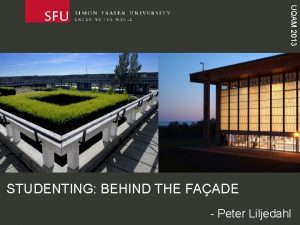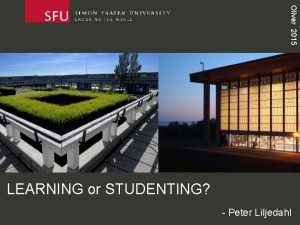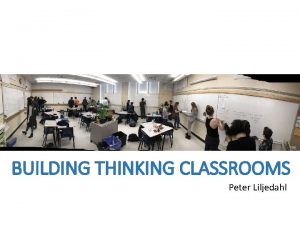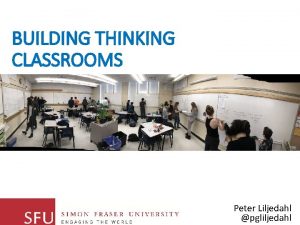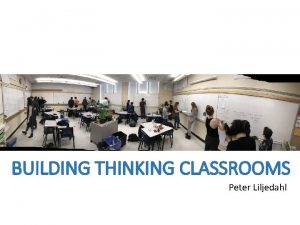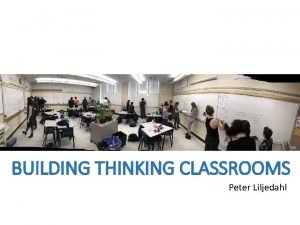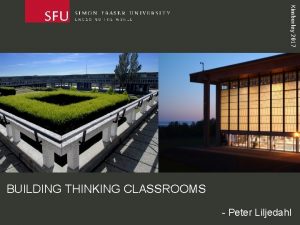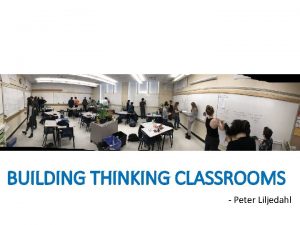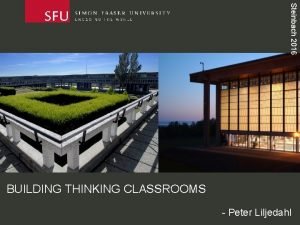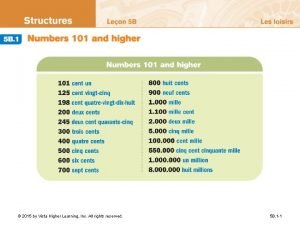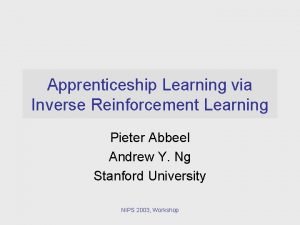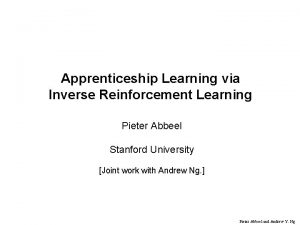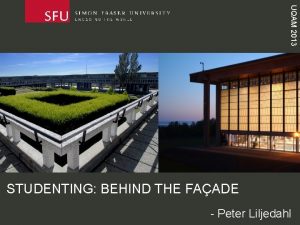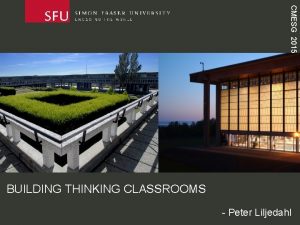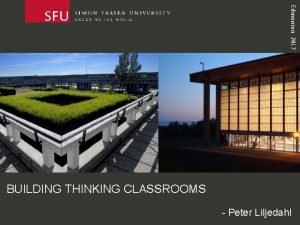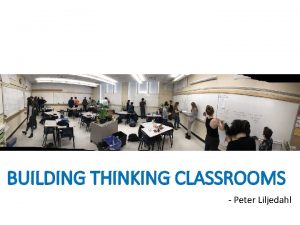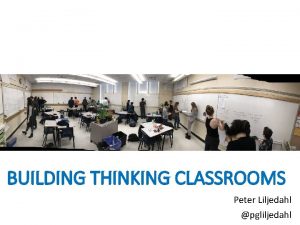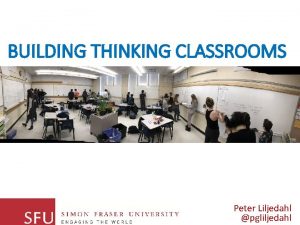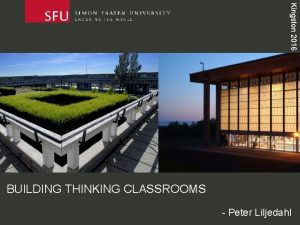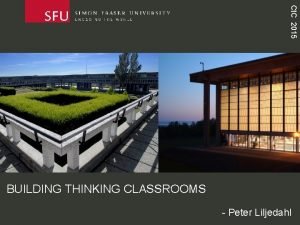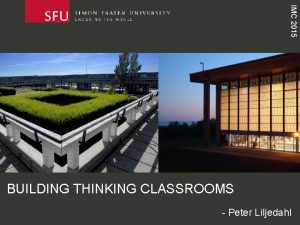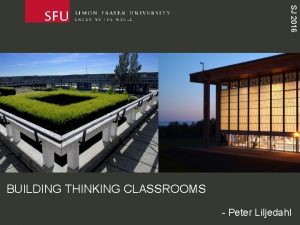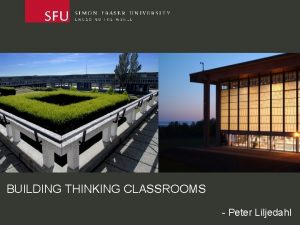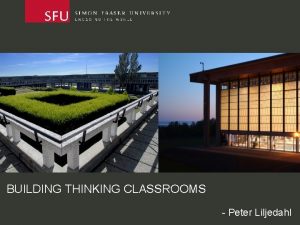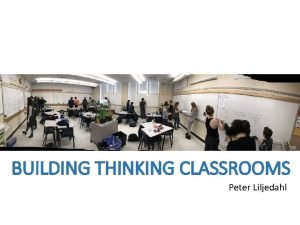Oliver 2015 LEARNING or STUDENTING Peter Liljedahl Oliver







![T S n=32 T N E 0% Y [CATEGOR R O EG [CAT ] T S n=32 T N E 0% Y [CATEGOR R O EG [CAT ]](https://slidetodoc.com/presentation_image/1764931eae0a0d6e0869b698e89f1243/image-8.jpg)
![STUDENTING Oliver 2015 [T]hings that students do such as ‘psyching out’ teachers, figuring out STUDENTING Oliver 2015 [T]hings that students do such as ‘psyching out’ teachers, figuring out](https://slidetodoc.com/presentation_image/1764931eae0a0d6e0869b698e89f1243/image-9.jpg)
![T S n=32 T N E 0% Y [CATEGOR R O EG [CAT ] T S n=32 T N E 0% Y [CATEGOR R O EG [CAT ]](https://slidetodoc.com/presentation_image/1764931eae0a0d6e0869b698e89f1243/image-10.jpg)
![GAMING [PERCENTAGE] 0% NOW YOU TRY ONE Liljedahl, P. & Allan, D. (2013). Studenting: GAMING [PERCENTAGE] 0% NOW YOU TRY ONE Liljedahl, P. & Allan, D. (2013). Studenting:](https://slidetodoc.com/presentation_image/1764931eae0a0d6e0869b698e89f1243/image-11.jpg)



















- Slides: 30

Oliver 2015 LEARNING or STUDENTING? - Peter Liljedahl

Oliver 2015 If 6 cats can kill 6 rats in 6 minutes, how many cats are required to kill 100 rats in 50 minutes? - Lewis Carroll MS. AHN’S CLASS (2003)

If 6 cats can kill 6 rats in 6 minutes, how many cats are required to kill 100 rats in 50 minutes? - Lewis Carroll MS. AHN’S CLASS (2003) Oliver 2015 ! G N I H T O N

Oliver 2015 MS. AHN’S CLASSROOM UNDERSTANDING NON-THINKING CLASSROOMS BUILDING THINKING CLASSROOMS 12 YEARS OF RESEARCH

Oliver 2015 UNDERSTANDIN G NON-THINKING CLASSROOMS

HOMEWORK TAKING NOTES REVIEW LECTURE GROUP WORK CONTEXT OF RESEARCH Oliver 2015 NOW YOU TRY ONE

HOMEWORK TAKING NOTES REVIEW LECTURE GROUP WORK CONTEXT OF RESEARCH Oliver 2015 NOW YOU TRY ONE
![T S n32 T N E 0 Y CATEGOR R O EG CAT T S n=32 T N E 0% Y [CATEGOR R O EG [CAT ]](https://slidetodoc.com/presentation_image/1764931eae0a0d6e0869b698e89f1243/image-8.jpg)
T S n=32 T N E 0% Y [CATEGOR R O EG [CAT ] (n=2) Y NAME] E AM N[CATEGOR (n=3) Checking Y NAME] Understanding (n=4) D U (n=6) catching up on notes (n=0) NOW YOU TRY ONE Oliver 2015 G IN [CATEGOR Y NAME] (n=17)
![STUDENTING Oliver 2015 Things that students do such as psyching out teachers figuring out STUDENTING Oliver 2015 [T]hings that students do such as ‘psyching out’ teachers, figuring out](https://slidetodoc.com/presentation_image/1764931eae0a0d6e0869b698e89f1243/image-9.jpg)
STUDENTING Oliver 2015 [T]hings that students do such as ‘psyching out’ teachers, figuring out how to get certain grades, ‘beating the system’, dealing with boredom so that it is not obvious to teachers, negotiating the best deals on reading and writing assignments, threading the right line between curricular and extra-curricular activities, and determining what is likely to be on the test and what is not. Fenstermacher (1994, p. 1)
![T S n32 T N E 0 Y CATEGOR R O EG CAT T S n=32 T N E 0% Y [CATEGOR R O EG [CAT ]](https://slidetodoc.com/presentation_image/1764931eae0a0d6e0869b698e89f1243/image-10.jpg)
T S n=32 T N E 0% Y [CATEGOR R O EG [CAT ] (n=2) Y NAME] E AM N[CATEGOR (n=3) Checking Y NAME] Understanding (n=4) D U (n=6) catching up on notes (n=0) NOW YOU TRY ONE Oliver 2015 G IN [CATEGOR Y NAME] (n=17)
![GAMING PERCENTAGE 0 NOW YOU TRY ONE Liljedahl P Allan D 2013 Studenting GAMING [PERCENTAGE] 0% NOW YOU TRY ONE Liljedahl, P. & Allan, D. (2013). Studenting:](https://slidetodoc.com/presentation_image/1764931eae0a0d6e0869b698e89f1243/image-11.jpg)
GAMING [PERCENTAGE] 0% NOW YOU TRY ONE Liljedahl, P. & Allan, D. (2013). Studenting: The case of "now you try one". Proceedings of the 37 th Conference of the PME, Vol. 3, pp. 257 -264. Kiel, Germany: PME. Oliver 2015 n=32

Oliver 2015 TAKE NOTES keep up n=11 yes n=3 don’t keep up n=16 don’t use notes n=27 USE NOTES TO STUDY TAKING NOTES (n=30) don’t n=3

GAMING 63% GAMING 90% USE NOTES TO STUDY TAKING NOTES (n=30) Oliver 2015 TAKE NOTES

ALTERNATE IDEAS teacher is wrong GAMING institutional norms WITH FAÇADE (intentional) avoidance economy of action BEATING THE SYSTEM NO FAÇADE (unintentional) wrong objective doing being practical rationality wrong rules FRAMEWORK OF GAMING … Oliver 2015 preferred learning style

Oliver 2015 BUILDING THINKING CLASSROOMS

worksho p improve thinking some were able to do it they needed a lot of help they loved it they don’t know how to work together • they got it quickly and didn't want to do any more • they gave up early FILTERED THROUGH STUDENTS EARLY (NAÏVE) EFFORTS Oliver 2015 worksho p • •

Oliver 2015 STUDENT NORMS REALIZATION

Oliver 2015 CLASSROOM NORMS REALIZATION

Oliver 2015 INSTITUTIONAL NORMS REALIZATION

Oliver 2015 CASTING ABOUT (n = 300+)

tasks hints and extensions how we give the problem how we answer questions how we level room organization how groups are formed student work space how we give notes assessment … THINGS I (WE) TRIED Oliver 2015 • • •

POSITIVE EFFECT tasks good tasks hints and extensions managing flow how we give the problem oral vs. written how we answer questions 3 types of questions how we level to the bottom room organization defronting the room how groups are formed visibly random groups student work space vertical non-permanent surfaces how we give notes don't assessment 4 purposes … FINDINGS Oliver 2015 VARIABLE

• answering questions • oral instructions • defronting the room • assessment • flow • good tasks • vertical nonpermanent surfaces • visibly random groups FINDINGS – BIGGEST IMPACT Oliver 2015 • levelling

• answering questions • oral instructions • defronting the room • assessment • flow • good tasks • vertical nonpermanent surfaces • visibly random groups FINDINGS – BIGGEST IMPACT Oliver 2015 • levelling

Oliver 2015 THANK YOU! liljedahl@sfu. ca www. peterliljedahl. com/presentations

Oliver 2015 VERTICAL NON-PERMANENT SURFACES

horizontal non-perm vertical permanent horizontal permanent notebook N (groups) 10 10 9 9 8 time to task 12. 8 sec 13. 2 sec 12. 1 sec 14. 1 sec 13. 0 sec first notation 20. 3 sec 23. 5 sec 2. 4 min 2. 1 min 18. 2 sec discussion 2. 8 2. 2 1. 5 1. 1 0. 6 eagerness 3. 0 2. 3 1. 2 1. 0 0. 9 participation 2. 8 2. 3 1. 8 1. 6 0. 9 persistence 2. 6 1. 8 1. 9 mobility 2. 5 1. 2 2. 0 1. 3 1. 2 non-linearity 2. 7 2. 9 1. 0 1. 1 0. 8 EFFECT ON STUDENTS Oliver 2015 vertical non-perm

horizontal non-perm vertical permanent horizontal permanent notebook N (groups) 10 10 9 9 8 time to task 12. 8 sec 13. 2 sec 12. 1 sec 14. 1 sec 13. 0 sec first notation 20. 3 sec 23. 5 sec 2. 4 min 2. 1 min 18. 2 sec discussion 2. 8 2. 2 1. 5 1. 1 0. 6 eagerness 3. 0 2. 3 1. 2 1. 0 0. 9 participation 2. 8 2. 3 1. 8 1. 6 0. 9 persistence 2. 6 1. 8 1. 9 mobility 2. 5 1. 2 2. 0 1. 3 1. 2 non-linearity 2. 7 2. 9 1. 0 1. 1 0. 8 EFFECT ON STUDENTS Liljedahl, P. (in press). Building thinking classrooms: Conditions for problem solving. In P. Felmer, J. Kilpatrick, & E. Pekhonen (eds. ) Posing and Solving Mathematical Problems: Advances and New Perspectives. New York, NY: Springer. Oliver 2015 vertical non-perm

Oliver 2015 VISIBLY RANDOM GROUPS

EFFECT ON STUDENTS Oliver 2015 • students become agreeable to work in any group they are placed in • there is an elimination of social barriers within the classroom • mobility of knowledge between students increases • reliance on co-constructed intra- and inter-group answers increases • reliance on the teacher for answers decreases • engagement in classroom tasks increase • students become more enthusiastic about mathematics class Liljedahl, P. (2013). The affordances of using visually random groups in a mathematics classroom. In Y. Li, E. Silver, & S. Li (eds. ) Transforming Mathematics Instruction: Multiple Approaches and Practices. New York, NY: Springer.
 Studenting
Studenting Oliver liljedahl
Oliver liljedahl Peter liljedahl
Peter liljedahl Peter liljedahl
Peter liljedahl Peter liljedahl thinking classrooms
Peter liljedahl thinking classrooms Peter liljedahl building thinking classrooms
Peter liljedahl building thinking classrooms Peter liljedahl thinking classrooms
Peter liljedahl thinking classrooms Peter liljedahl building thinking classrooms
Peter liljedahl building thinking classrooms Thinking classroom
Thinking classroom Thinking classroom peter liljedahl
Thinking classroom peter liljedahl Cuadro comparativo de e-learning
Cuadro comparativo de e-learning 2015 vista higher learning inc
2015 vista higher learning inc Team learning senge
Team learning senge Lda supervised or unsupervised
Lda supervised or unsupervised Concept learning task in machine learning
Concept learning task in machine learning Analytical learning in machine learning
Analytical learning in machine learning Example of habituation
Example of habituation Eager learning algorithm
Eager learning algorithm Define conceptual learning
Define conceptual learning Inductive and analytical learning
Inductive and analytical learning Apprenticeship learning via inverse reinforcement learning
Apprenticeship learning via inverse reinforcement learning Apprenticeship learning via inverse reinforcement learning
Apprenticeship learning via inverse reinforcement learning Deductive learning vs inductive learning
Deductive learning vs inductive learning Pac learning model in machine learning
Pac learning model in machine learning Contoh unsupervised learning
Contoh unsupervised learning Pac learning model in machine learning
Pac learning model in machine learning Inductive and analytical learning in machine learning
Inductive and analytical learning in machine learning Instance based learning in machine learning
Instance based learning in machine learning Inductive learning machine learning
Inductive learning machine learning First order rule learning in machine learning
First order rule learning in machine learning Collaborative learning vs cooperative learning
Collaborative learning vs cooperative learning
